News
Understanding the Technical Specifications and Installation Guide for Best Solar Street Lights
As urban areas continue to expand and the demand for sustainable energy solutions grows, Solar Street Lights have emerged as a key component in achieving smart city initiatives. According to a report by the International Energy Agency, the global market for solar street lighting is expected to reach USD 7.5 billion by 2025, reflecting a significant shift towards renewable energy applications in public infrastructure. These innovative lighting solutions not only enhance public safety and reduce crime rates but also decrease energy costs and carbon footprints.

However, selecting high-quality Solar Street Lights requires a thorough understanding of their technical specifications and installation requirements. In this blog, we will delve into the essential criteria for identifying reputable suppliers, ensuring that municipalities and organizations make informed decisions when investing in these eco-friendly technologies.
Understanding the Importance of Solar Street Light Technical Specifications in Urban Planning
As urban areas grow and evolve, the importance of integrating sustainable solutions into city planning becomes increasingly clear. Solar street lights represent a critical component of this transition, providing not only illumination but also a greener alternative to traditional lighting systems. Understanding the technical specifications of these solar solutions is essential for urban planners and decision-makers alike. Key specifications such as lumens output, solar panel efficiency, battery capacity, and durability can significantly influence the effectiveness and reliability of solar street lights in different urban environments.

Moreover, the role of solar street lights extends beyond mere functionality; they contribute to the aesthetic and ecological balance of urban spaces. By considering technical specifications during the planning phase, cities can ensure that solar street lights meet the unique needs of various neighborhoods, enhancing public safety and visual appeal. This proactive approach fosters community acceptance and encourages widespread adoption of renewable energy solutions, ultimately paving the way for smarter, more sustainable cities. The careful selection of these specifications not only optimizes energy usage but also aligns with broader goals of urban sustainability and resilience against climate change.
Key Features to Consider When Choosing High-Quality Solar Street Lights for Sustainability
When selecting high-quality solar street lights, there are several key features to consider that directly impact sustainability and efficiency. First, the type of solar panel plays a crucial role; monocrystalline panels, although more expensive, tend to offer higher efficiency and better performance in low-light conditions compared to polycrystalline panels. This efficiency is vital in ensuring that solar street lights can function optimally, even during cloudy days or in shaded areas. Additionally, the quality of the LED bulbs used not only influences brightness but also energy consumption. A good LED system should provide high lumen output while consuming minimal wattage.
Another important factor is the battery capacity and type. A robust battery ensures that the solar street lights can store sufficient energy during the day and provide illumination throughout the night. Lithium-ion batteries are often preferred for their longevity and faster charging times compared to traditional lead-acid batteries. Furthermore, the integration of smart technology can enhance the functionality of these lights. Features such as motion sensors and smart controls not only promote energy conservation but also improve safety in public spaces by optimizing lighting when needed. By focusing on these critical aspects, one can select solar street lights that are not only reliable but also support sustainable energy initiatives.
Exploring Global Sales Trends of Solar Street Lights: A Market Overview
The global solar street lighting market is experiencing significant growth, with projections indicating a leap from a valuation of USD 5.69 billion in 2024 to an impressive USD 23.59 billion by 2033. This expansion reflects a compound annual growth rate (CAGR) of 17.12%, driven by increasing urbanization and the demand for sustainable energy solutions. As cities embrace smart lighting technologies, the integration of solar solutions becomes increasingly vital in enhancing urban infrastructure while reducing energy costs.
Furthermore, the solar street lighting sector is set to continue its upward trajectory, estimated to reach USD 16.9 billion by 2030, following an exceptional CAGR of 16.0% from 2023. This growth not only underscores the rising preference for renewable energy sources but also highlights the commitment of municipalities to improve public safety, visibility, and community aesthetics without compromising environmental responsibilities. As the market matures, innovation in technology and design will likely lead to more efficient and reliable solar street lighting options, cementing its role in the lighting industry’s future.

Installation Best Practices for Optimizing Solar Street Light Performance in Different Environments
When installing solar street lights, understanding the specific environmental conditions is crucial for optimal performance. Different settings, such as urban areas, parks, and rural locations, pose unique challenges that can affect the effectiveness of solar lighting systems. For instance, in urban environments, where buildings may obstruct sunlight, it's essential to strategically position the solar panel to maximize exposure.
Tip: Ensure that the solar panels are mounted at an angle that captures the most sunlight throughout the day, taking into account the local latitude and seasonal variations.
In contrast, installations in rural areas often have ample sunlight but may face issues with wildlife interference or harsh weather conditions. In such cases, selecting robust materials that can withstand the elements is critical. Proper height placement is also important to deter animals from damaging the fixtures.
Tip: Use weather-resistant coatings and secure the solar lights firmly to prevent damage during storms or high winds. Regular maintenance checks can also help ensure longevity and effectiveness.
Quality Assurance Standards for Solar Street Lights: Ensuring Long-lasting Performance and Reliability
When selecting solar street lights, quality assurance standards play a crucial role in ensuring long-lasting performance and reliability. Manufacturers should adhere to international certifications like ISO 9001, which emphasizes consistent quality management systems. Additionally, look for products with certifications such as CE and RoHS that indicate safety and environmental compliance. These standards help assure users that the lights meet stringent performance benchmarks and are built to withstand harsh weather conditions.
**Tip:** Always check customer reviews and case studies to gauge the real-world performance of solar street lights. This feedback can often reveal issues related to durability and performance over time.
Moreover, ensure that the solar street lights you choose come equipped with high-quality photovoltaic cells and durable housing materials. Investigating the warranty offered by the manufacturer can also provide insight into their confidence in the product. A longer warranty typically signals a commitment to quality, ensuring that your investment will last for years.
**Tip:** When installing solar street lights, consider the local climate and installation location to maximize sunlight exposure and functionality. Proper placement and height can significantly improve the efficiency and lifespan of your solar street lights.
Performance Comparison of Solar Street Lights Based on Technical Specifications
This chart compares three different solar street light models based on key technical specifications such as light efficacy, battery capacity, solar panel area, and lifespan. These parameters are crucial for determining the performance and reliability of solar street lights.
